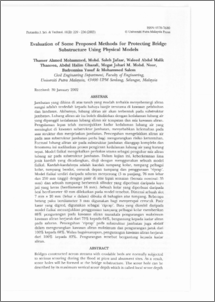Citation
Mohammed, Thamer Ahmed and Jafaar, Mohd Saleh and Thanoon, Waleed Abdulmalik and Ghazali, Abdul Halim and Megat Mohd Noor, Megat Johari and Yusuf, Badronnisa and Salem, Mohammed
(2003)
Evaluation of Some Proposed Methods for Protecting Bridge
Substructure Using Physical Models.
Pertanika Journal of Science & Technology, 11 (2).
pp. 229-236.
ISSN 0128-7680
Abstract
Bridges constructed across streams with erodable beds are normally subjected
to serious scouring during the flood at piers and abutment sites. As a result,
scour holes will be formed at the bridge substructure. The scour hole can be
described by its maximum vertical scour depth which is called local scour depth and by the size of its projected scour area. Experience has shown that
progressive depth of scour holes at the site of bridge substructures could
undermine the foundation and result in bridge failure. Protection against
scouring for constructed bridges is necessary to minimize the risk of failure.
The formation of the scour hole at the bridge substructure is considered as very
complex and this phenomenon is so involved that only very limited success has
been made to predict the size of the scour hole computationally. Physical
model remains the principal tool employed for estimating the size of scour
hole at the site of bridge substructure. In this study, the efficiency of five
different proposed methods of protecting the bridge substructure were tested
using a physical model. These methods are piers with collar, pier with multiple
collars, pier with slot, piles in front of piers, and using riprap. The physical
model comprises a tilted flume (5 m long, 76 mm wide and 250 mm high) with
sand on its bed (nominal size =0.35 mm) and a single circular cylindrical pier
model which was made of hard teak wood (diameter =16 mm). A collar form
steel with a diameter of 40 mm was attached to the pier model. A slot of a
dimension 7 mm x 20 mm (width x depth) was opened in the upper side of
the pier. Steel nails 3 mm in diameter each were used to simulate the piles.
Coarse graded gravel was used as a riprap. Data collected from the physical
model showed that using multiple collars around the pier can give 88%
reduction in the scour area while the reduction in the maximum scour depth
ranges from 73% to 64%, depending on the flow rate in the flume. It was
observed that the riprap protection at the bridge substructure is also effective
in reducing the maximum scour depth and reduction ranges from 100% to
68%. However, the reduction in the scour area ranges from 100% to 83%. The
reduction was also dependent on the flow rate.
Download File
![[img]](http://psasir.upm.edu.my/style/images/fileicons/application_pdf.png)  Preview |
|
PDF
Evaluation_of_Some_Proposed_Methods_for_Protecting_Bridge.pdf
Download (2MB)
|
|
Additional Metadata
Actions (login required)
 |
View Item |



